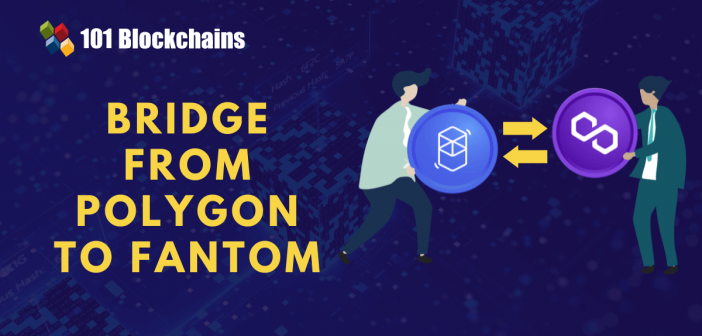Learn how blockchain truly works, master key definitions, and uncover what makes smart contracts so "smart." Dive into the fundamentals, gain valuable insights, and start your blockchain journey today!

- Guides
Georgia Weston
- on November 04, 2022
How to Bridge from Polygon (MATIC) to Fantom (FTM)?
The scope for interoperability within the blockchain landscape has constantly been growing in recent times. The ability to move assets freely among different blockchain networks can provide a formidable boost in efficiency for developers and users. The need for a Polygon to Fantom Bridge might involve various reasons, including the need to lower transaction costs. Interestingly, you can explore multiple solutions for bridging tokens from Matic to Fantom.
However, it is also important to learn the basics and functionalities of both blockchain networks. It can help you understand the reasons behind bridging MATIC to the Fantom blockchain. The following discussion offers introductory overviews for Polygon and Fantom alongside the outline of methods and alternatives for bridging tokens between the networks.
Excited to develop a comprehensive understanding of Polygon? Enroll in Polygon Fundamentals Course
What is Polygon?

Polygon is one of the rapidly growing and popular layer 2 solutions running in parallel to the Ethereum blockchain. The primary functionalities of Polygon focus on enabling faster transactions alongside reducing fees. If you want to learn about a MATIC to FTM Bridge, then you must know that MATIC is the native cryptocurrency of the network. MATIC serves a significant role in making payments for the transaction fees or staking and other uses on the Polygon network.
The radical growth in NFT markets alongside DeFi applications and Play to Earn or P2E games has spelled critical trouble for Ethereum.
How? Ethereum is the top blockchain network of choice for these applications, owing to the functionalities for writing smart contracts according to different use cases.
However, the increasing number of applications means more transactions, thereby leading to congestion of the network. Therefore, Polygon delivers an important layer 2 scaling solution tailored to offering low costs and faster transactions. It works as a faster parallel blockchain operating beside the main Ethereum blockchain.
You can use the best Polygon Bridge for moving your crypto assets to Polygon, thereby enabling interoperability with crypto apps. The primary highlight of Polygon refers to the ability to use apps that were previously accessible through the main Ethereum blockchain.
Learn about the fundamental terms and concepts of the Polygon network with Polygon Flashcards
MATIC Token
If you want to find a Polygon bridge, you must be curious about the native token of the network. Polygon features its own cryptocurrency, the MATIC token. It is useful for paying fees on Polygon, governance as well and staking. MATIC token owners have voting privileges on proposals regarding updates or changes in Polygon. You can purchase and sell MATIC through popular crypto exchanges. Interestingly, the MATIC token reminisces the earlier stage of the project’s development in 2017, when it was launched as Matic Network.
Working of Polygon
The search for answers to “How do you bridge from MATIC to Fantom?” would also showcase details about the working of Polygon. You can think of Polygon as the experience of an express train. Even if it follows the same route to reach its destination, the express train would have limited stops than a passenger train and would move farther.
Now, you can imagine the Ethereum blockchain as the local network which has many developers and users on board. Each passenger has a specific destination and has different priorities regarding reaching their destination. What if you don’t like to wait in the crowded local train to reach your destination? You can go on the express train.
Polygon depends on different technologies for creating a parallel and efficient blockchain that can link directly with the main Ethereum chain. The network leverages a Proof of Stake consensus mechanism for creating new MATIC tokens and securing the network. It is also important to remember that you can obtain new MATIC tokens only through staking.
Build your identity as a certified blockchain expert with 101 Blockchains’ Blockchain Certifications designed to provide enhanced career prospects.
Importance of Validators and Delegators
The working of a Polygon Fantom bridge can become more understandable for you with a better understanding of validators and delegators in Polygon.
You must note that validators would work on the heavy lifting tasks, such as verification of new transactions and adding them to the blockchain. As a result, they can grab a share of the fees alongside the newly minted MATIC. At the same time, it is also important to remember that validators have to showcase commitment to the solution by staking MATIC tokens and running a full-time node. Validators can lose their staked MATIC tokens in the event of any malicious activity or errors, such as downtime due to a lack of internet connection.
On the other hand, delegators could rely on their trusted validator for indirect staking of MATIC tokens. The staking approach of delegators showcases a low-commitment approach towards staking. However, the selection of a trusted validator is crucial for avoiding unwanted loss of your assets due to malicious actions or errors of validators.
Usability of Polygon Network
The final and most striking highlight in an introductory guide to the Polygon network would refer to its usability. As a matter of fact, the easier usability of Polygon could help you use a MATIC to FTM Bridge with ease. First of all, you must note that the Polygon Network offers access to many services and apps available on Ethereum.
The noticeable trait of Polygon is the availability of services at a low cost of transaction fees for traditional activities suited to main Ethereum networks. Users can go for decentralized exchanges such as SushiSwap or yield-generating protocols such as Aave and NFT marketplaces such as OpenSea. Furthermore, it also creates “no-loss prize games” such as Pool together.
You could send stablecoins to the Polygon network to bridge some of your assets. Before trying out the Polygon network, you would need stablecoins in a supported crypto wallet, such as Coinbase Wallet. The detailed overview of Polygon basics and its usability showcase the necessity of bridging some MATIC tokens for making transactions. Users can capitalize on the low transaction fees and near-instant transaction settlement times. As a result, users could gain a firsthand experience of DeFi protocols and their usability.
Want to learn the basic and advanced concepts of Stablecoin? Enroll Now in Stablecoin Fundamentals Masterclass
What is Fantom?

The next player in the Polygon to Fantom Bridge would refer to the Fantom blockchain. In the case of Ethereum-based protocols, the transaction fees can be quite critical on days with higher congestion. Due to heavy demand for the network, the transaction fees can effectively surpass the value of the complete transaction. For example, you might have to pay more than what you imagine for swapping crypto assets, which may amount to just below a dollar.
In this situation, layer 1 blockchain networks such as Solana and Fantom have emerged as vital answers. Fantom is practically a smart contract supporting blockchain featuring its own native token, the FTM. The Fantom blockchain launched its main network in December 2019 after raising $40 million. Interestingly, Fantom features a cost-efficient and faster approach for supporting the network’s own DeFi industry.
Working of Fantom
You can learn about the workings of Fantom Bridge in detail by reflecting on the workings of Fantom itself. The basic design of the Fantom blockchain involves a directed acyclic graph or DAG. In the case of a DAG, the transaction histories are documented in the form of a hash graph or a graph representing blockchain hashes.
The next crucial highlight in the working of Fantom refers to Lachesis, the leaderless consensus mechanism of the blockchain. It actually serves as the variant for Proof of Stake consensus, also referred to as asynchronous byzantine fault tolerant or aBFT. One of the significant advantages of Fantom is the ability to operate seamlessly, even in cases where one-third of the transaction data is invalid.
You can understand the working of the best Polygon Bridge to Fantom by identifying how the blockchain nodes could ensure independent validation of transactions. One of the proven highlights of Fantom refers to the asynchronous BFT, which ensures the accuracy of transaction validity across multiple transactions. In the case of Fantom, transactions could take around two seconds for confirmation.
Another special highlight of Fantom refers to the compatibility with Ethereum Virtual Machine or EVM, unlike its competitor Solana. The EVM compatibility enables easier portability of Ethereum dApps on Fantom. It is important to remember that Polygon is also EVM compatible, and the MATIC token can be bridged to Fantom. You must also notice that the FTM token is available in the BEP-20 standard and ERC-20 standard, thereby ensuring compliance with Binance Smart Chain and Ethereum token standards.
Special Highlights of Fantom
The next crucial aspect you need to learn before finding out “How do you bridge from MATIC to Fantom?” is an outline of the special highlights about Fantom. You can credit the success of Fantom to the competition among the layer 1 blockchain networks. The popular layer 1 blockchain for developing smart contracts and dApps, Ethereum, is expensive and slow to use. Unless the platform gets new updates, the performance of the Ethereum blockchain will remain the same. However, people who want to leverage DeFi applications have to encounter issues regarding the high costs of ETH-native DeFi apps.
Some of the common solutions, such as Optimism, Loopring, and Arbitrum, serve as examples of Layer 2 solutions. These solutions can work on enhancing the Ethereum user experience without any compromises in security for Ethereum. On the other hand, some solutions attempted to provide a completely new alternative to Ethereum.
Popular examples of layer 1 blockchain networks include Solana, Terra, Avalanche, and Polkadot. It is also important to note that the native coins have been through a considerable dip from all-time highs. Interestingly, each layer 1 blockchain has led to the creation of many DeFi applications or completely different ecosystems. Recent data suggests that the TVL or total value locked in DeFi apps on Fantom amounted to almost $7.25 billion.
Start learning Blockchain with World’s first Blockchain Skill Paths with quality resources tailored by industry experts Now!
Uses of Fantom Blockchain
Before you find out more details about the Polygon Bridge, you must notice some of the interesting applications developed on the Fantom blockchain. Popular examples of applications on Fantom blockchain include Fantom Finance, Solidly, SpookySwap, and Multichain. Each application serves distinct functions, such as Fantom Finance offering synthetic mining, decentralized lending, trading, and liquidity staking functionalities.
On the other hand, the Multichain works as a cross-chain router protocol, while SpookySwap serves as a decentralized automatic market maker. Solidly is an innovative decentralized exchange developed over the Fantom blockchain and provides the assurance of limited slippage risks. Another example of applications developed on Fantom refers to the decentralized lending protocol, Geist Finance.
Is it Possible to Bridge Polygon to Fantom?
The explicit introduction to Polygon and Fantom blockchain networks serves as a foundational impression pertaining to their functionalities. With the help of the seamless movement of crypto assets between these two networks, developers and users can extract many promising benefits. Interestingly, you can find a Polygon Fantom Bridge and achieve a seamless transition of assets between these blockchain networks. As of now, you can discover four specific decentralized exchanges supporting the direct transfer of assets between the Fantom network and the Polygon main network.
The DEXs you can use for bridging MATIC to FTM include the Synapse Protocol, SpookySwap, Allbridge, and Multichain. In most cases, the recommended tool for bridging between Polygon mainnet and Fantom Opera network would be Synapse protocol. The best highlight of Synapse protocol is the assurance of lower bridging fees, varied selection of bridging tokens, and faster transaction time.
Synapse protocol delivers a reliable MATIC to FTM bridge with the quickest turnaround time of less than a minute. In addition, the Synapse protocol also ensures lower fees for bridging MATIC to the FTM network with the lowest slippage. It is also important to remember that Synapse boasts of humongous bridge volume for any bridging protocol, which can provide backing for popularity and security.
Excited to develop a comprehensive understanding of Polygon web3 development? Enroll Now in Polygon Web3 Development Course!
Steps for Bridging from Polygon to Fantom
The Synapse Protocol emerges as the top candidate for bridging tokens to Fantom from the Polygon mainnet. First of all, you must connect your web3 wallets, such as Metamask, Binance Smart Chain wallet, or Coinbase wallet, to Synapse. You can start with an example of bridging SYN or the native token of Synapse as the choice of token for bridging. Remember that you can also use bridges for sending USDC, DAI, and USDT between the blockchain networks. Here are the simple steps for bridging from Polygon to the Fantom network.
- Access the official website of Synapse protocol and connect your crypto wallet, preferably Metamask.
- Choose Polygon and Fantom as your selections of the two blockchain networks in the bridge.
- Enter the details of the number of SYN tokens or the other token you want to bridge between the networks.
- Once you confirm the transactions on the Metamask wallet, you can receive the funds within minutes.
Final Words
The introductory overview of Polygon and Fantom revealed many interesting details about their value. With the ideal Polygon to Fantom Bridge, crypto or web3 users can navigate new opportunities for leveraging their crypto assets. Bridges can serve as a crucial value advantage for aspirants who want to make the most of new DeFi apps without doling out unreal amounts of transaction fees. The significant implications pertaining to Polygon as a layer 2 scalability solution and Fantom as a layer 1 scalability solution establish the relationship between them.
At the same time, the discussion also emphasized the necessity of selecting a credible bridge. Synapse protocol delivers a productive solution for bridging from MATIC to Fantom with faster transaction time and lower costs.
Learn more about the two blockchain networks and the best options for bridging them now.
*Disclaimer: The article should not be taken as, and is not intended to provide any investment advice. Claims made in this article do not constitute investment advice and should not be taken as such. 101 Blockchains shall not be responsible for any loss sustained by any person who relies on this article. Do your own research!






